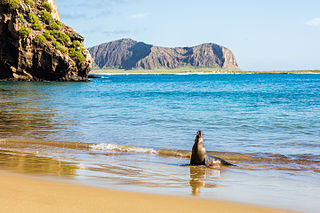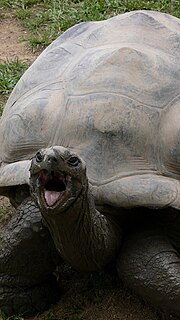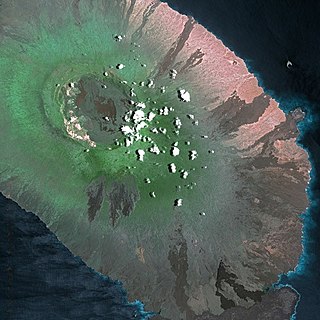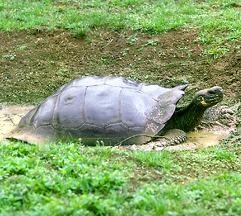Related Research Articles

The Galápagos Islands, part of the Republic of Ecuador, are an archipelago of volcanic islands distributed on either side of the equator in the Pacific Ocean surrounding the centre of the Western Hemisphere. Located 906 km (563 mi) west of continental Ecuador, the islands are known for their large number of endemic species that were studied by Charles Darwin during the second voyage of HMS Beagle. His observations and collections contributed to the inception of Darwin's theory of evolution by means of natural selection.

Darwin's finches are a group of about 18 species of passerine birds. They are well known for their remarkable diversity in beak form and function. They are often classified as the subfamily Geospizinae or tribe Geospizini. They belong to the tanager family and are not closely related to the true finches. The closest known relative of the Galápagos finches is the South American Tiaris obscurus. They were first collected by Charles Darwin on the Galápagos Islands during the second voyage of the Beagle. Apart from the Cocos finch, which is from Cocos Island, the others are found only on the Galápagos Islands.

The Pinta Island tortoise, also known as the Pinta giant tortoise, Abingdon Island tortoise, or Abingdon Island giant tortoise, was a species of Galápagos tortoise native to Ecuador's Pinta Island.

The Charles Darwin Foundation was founded in 1959, under the auspices of UNESCO and the World Conservation Union. The Charles Darwin Research Station serves as headquarters for The Foundation, and is used to conduct scientific research and promote environmental education.

Galápagos is a province of Ecuador in the country's Insular region, located approximately 1,000 km (620 mi) off the western coast of the mainland. The capital is Puerto Baquerizo Moreno.

Harriet was a Galápagos tortoise who had an estimated age of 175 years at the time of her death in Australia. Harriet is one of the longest-lived known tortoises, behind Tu'i Malila, who died in 1965 at the age of 188, and possibly Adwaita, who died in 2006 at an estimated age of between 150 and 255 years. At the time of her death, she lived at the Australia Zoo which was owned by Steve and Terri Irwin.

San Cristóbal Island and named previously by the English as Chatham Island, is the easternmost island in the Galápagos archipelago, as well as one of the oldest geologically. It is administratively part of San Cristóbal Canton, Ecuador.

Isabela Island is the largest island of the Galápagos with an area of 4,586 square kilometres (1,771 sq mi) and length of 100 kilometres (62 mi), almost four times larger than Santa Cruz, the second largest of the archipelago. Isabela Island is larger than every other island in the Galápagos combined. It was named after Queen Isabella I of Castile. The island straddles the equator. This island was originally named Albemarle Island for the Duke of Albemarle by Ambrose Cowley, one of the first Europeans to set foot on the islands, in 1684.

Santa Cruz Island is one of the Galápagos Islands with an area of 986 km2 (381 sq mi) and a maximum altitude of 864 metres (2,835 ft). Situated in the center of the archipelago, Santa Cruz is the second largest island after Isabela. Its capital is Puerto Ayora, the most populated urban centre in the islands. On Santa Cruz, there are some small villages, whose inhabitants work in agriculture and cattle raising.

Floreana Island is an island of the Galápagos Islands. It was named after Juan José Flores, the first president of Ecuador, during whose administration the government of Ecuador took possession of the archipelago. It was previously called Charles Island, and Santa María after one of the caravels of Columbus.
The Galápagos Islands are located off the west coast of South America straddling the equator. The Galápagos are located at the confluence of several currents including the cold Humboldt Current traveling north from South America and the Panama Current traveling south from Central America make the islands cooler and provide the perfect environment for the unique mix of wildlife that inhabits the islands.

Galápagos National Park, established in 1959 and beginning operations in 1968, is Ecuador's first national park and a UNESCO World Heritage Site.

The Galápagos tortoise complex or Galápagos giant tortoise complex is a species complex of 15 very large tortoise species in the genus Chelonoidis. They are the largest living species of tortoise, with some modern Galápagos tortoises weighing up to 417 kg (919 lb). With lifespans in the wild of over 100 years, they are one of the longest-lived vertebrates. Captive Galapagos tortoises can live up to 177 years. For example, a captive individual, Harriet, lived for at least 175 years. Spanish explorers, who discovered the islands in the 16th century, named them after the Spanish galápago, meaning "tortoise".

Lonesome George was a male Pinta Island tortoise and the last known individual of the species. In his last years, he was known as the rarest creature in the world. George serves as an important symbol for conservation efforts in the Galápagos Islands and throughout the world.

Alcedo Volcano is one of the six coalescing shield volcanoes that make up Isabela Island in the Galapagos. The remote location of the volcano has meant that even the most recent eruption in 1993 was not recorded until two years later. It is also the only volcano in the Galapagos to have erupted rhyolite and basaltic lava.
Nicholas Oliver Lawson was a Norwegian-born, vice governor of Galápagos for the Republic of Ecuador. While there, he provided information which contributed to Charles Darwin's first realisation that species might be changeable, and eventually to Darwin's theorising about evolution.

The Hood Island giant tortoise is a species of Galápagos tortoise endemic to Española Island in the Galápagos.

The Santiago Island giant tortoise, also known commonly as the Santiago giant tortoise and the James Island tortoise, is a species of Galápagos tortoise in the family Testudinidae. The species is endemic to Santiago Island in the Galápagos.

Chelonoidis duncanensis, commonly known as the Pinzón Island giant tortoise, is a species of Galápagos tortoise endemic to Pinzón Island in the Galápagos.